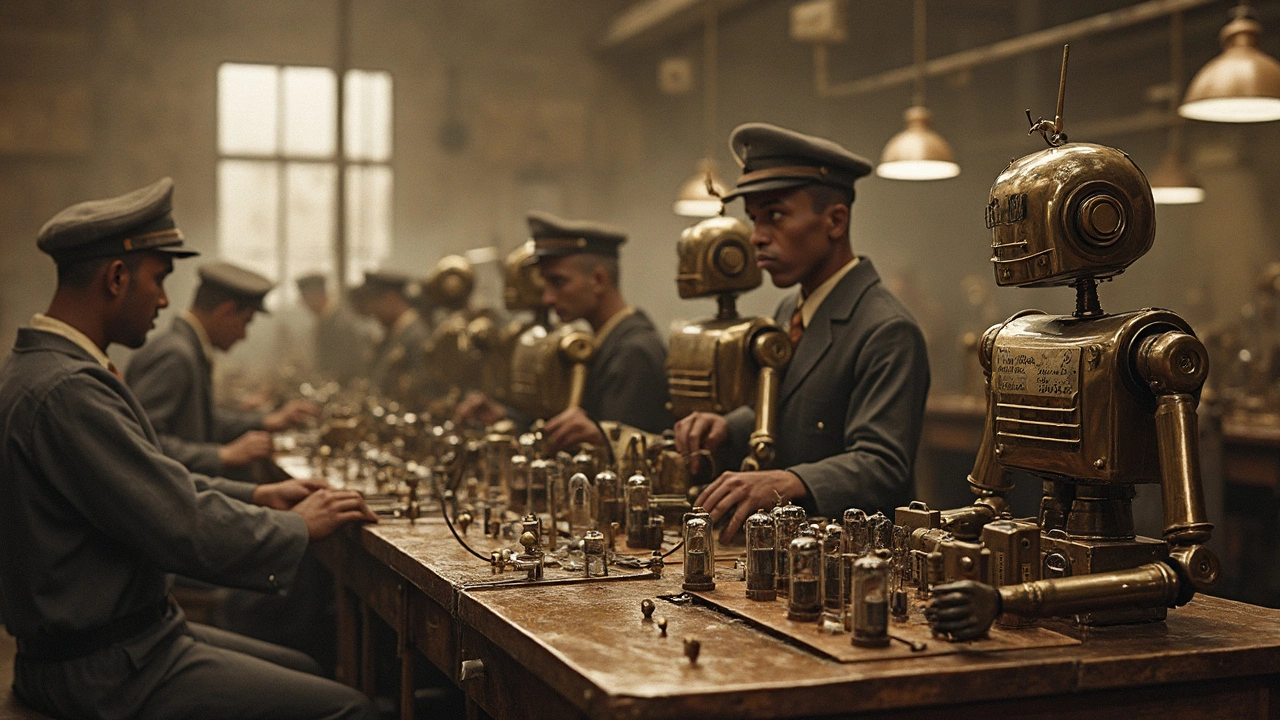Exploring Radio-Controlled Robots
 May, 20 2004
May, 20 2004
Radio-controlled robots are fascinating little machines that have come a long way since their military origins. Imagine a time when military engineers used radio waves to steer weapons and vehicles during the World Wars—it's like something straight out of a sci-fi movie! These innovations sparked the creation of the very first RC models. Now, they’re not just confined to battlefields or high-tech labs but are a fixture in hobbyist hangouts and industrial setups alike.
Initially, these gizmos were powered by old-school tech like vacuum tubes and transistors. But as tech evolved, so did the capabilities of RC robots. With gadgets like servos, enthusiasts could guide their creations through complex maneuvers with precision. It’s like turning every hobbyist into their own robot commander!
The story of RC robots gets a lot more interesting when you add in the people behind the scenes. Ever heard of the Good brothers? They and other pioneers like Ed Lorenze made sure that this nifty tech wasn’t just for the military anymore. They threw open the doors to the world of remote-controlled fun, paving the way for the cool stuff we have today—from drones to intricate model kits. And remember, it's not just about fun. Think of automated vehicles and drones in actual real-world applications. These robots are shaping both industries and our everyday lives.
- The Birth of RC Technology
- Evolving Beyond Military Use
- Key Innovators in the Field
- Modern-Day RC Technologies
- Real-Life Applications
The Birth of RC Technology
The story of radio-controlled robots starts not on a hobbyist's desk but on the battlefield. Back in the early 20th century, during the intense action of the World Wars, military minds were cooking up ways to use radio signals to direct weapons and vehicles remotely. Crazy, right? This was the birth of what we now call RC technology.
Military Roots
Picture this: the military needed to control devices from afar without risking human lives. So, they began experimenting with radio-controlled systems. During World War I, there were radio-controlled torpedoes and even pilotless airplanes. It was like laying down the blueprint for everything RC! Fast forward to World War II, and this tech saw more action, especially with radio-guided bombs.
Post-War Proliferation
After the wars, the shift from military to civilian use began. As soldiers returned home, some with technical skills honed on the battlefield, they started dabbling in the world of electronics and RC models. This ignited the imagination of hobbyist innovators, who spotted the potential for fun and creativity with these mechanisms. Hobbyists experimented with the radio gear, sparking the hobby culture that we see today.
Back then, they used whatever they could find, like vacuum tubes—a far cry from today's digital wizardry. But hey, from small beginnings come great things!
The Role of Pioneers
We owe a big thanks to the early innovators. Folks like the Good brothers made huge strides by managing to control models using vacuum tube technology. Their work led to the kind of rigs that enabled hobbyists to move beyond simple line-following gadgets. By the 1950s, RC models started to gain traction among the general public, paving the way for modern RC technology.
Evolving Beyond Military Use
It's pretty amazing to think that what started as military tech has now become a part of everyday life. Back in the day, radio-controlled robots were all about strategic advantage on the battlefield. Fast-forward to the decades following World War II, and you start to see these nifty devices breaking free from their martial roots.
One of the most significant shifts occurred in the 1950s through the 1970s, when hobbyists began to embrace this technology. Commercial kits sprung up everywhere. Suddenly, people could build and control their own models, just for the fun of it. This wasn’t just about boy racers and model aircraft enthusiasts—it was a movement.
The Rise of Hobby Culture
Hobby shops weren’t in short supply during these years, and the popularity of RC models took off. Advances in miniaturized electronics made it easier and more affordable for everyone to join in. You had folks like Ed Lorenze designing amateur systems that were easy to use and didn’t require a degree from MIT to figure out. It wasn’t long before entire communities grew around this engaging pastime.
Beyond Recreation: Industrial and Civilian Uses
The fun didn’t stop in the hobby shop. Industries quickly caught on, realizing that RC models could be handy for more than just entertainment. Think about things like drones being used in farming, where they help monitor crops, or in construction, where they survey sites. Automated vehicles would also form part of this transition — all thanks to these early innovations.
In the civilian sector, RC tech found its way into education and even into competitive arenas. Schools and colleges used them to teach basic electronics and engineering principles. Meanwhile, racing leagues and competitions sprang up, where skill and precision, much like traditional motor racing, took center stage.
It's fascinating to see how technology once meant for conflicts has evolved into something so integral in both play and work. Whether you're buzzing a drone over a field or tinkering in the garage, the evolution of radio-controlled robots shows the power of innovation and transformation.

Key Innovators in the Field
When we dive into the world of radio-controlled robots, it's impossible to overlook the trailblazers who've made a mark with their creative genius. These folks did more than just tinker—they laid the bedrock for the technology we enjoy today.
The Good Brothers
First up, the Good brothers—Bill and Walt. Imagine being in the early 1940s, where gadgets were nowhere near as flashy as they are today. These two brothers stepped up and crafted rudimentary vacuum tube-based control units. Yeah, they weren’t perfect, but these units formed the stepping stones to more polished radio controls. They were all about pushing boundaries and playing with what was considered cutting-edge back then.
Ed Lorenze
Then there’s Ed Lorenze, who threw down a gauntlet of his own. After WWII, he came up with his amateur designs that took local hobbyists by storm. His work popularized RC models among enthusiasts who wanted something hands-on and interactive. It's kinda like when the first smartphones came out, and suddenly everyone needed one. Lorenze made sure RC tech was not only accessible but also exciting for everyday folks.
Modern Innovators
Fast forward to today, and there are numerous companies and individuals continually innovating in the RC space. These days, it's all about proportional control, pulse-width modulation (PWM), and spread-spectrum technologies. Modern developers have made it so anyone can pick up a remote and make their own piece of engineering magic fly, roll, or drive.
Thanks to these groundbreakers, RC robots have powered into everything from recreational fun to serious scientific and military applications. They're not just toy-like models anymore; they're tools and sometimes lifesavers in various fields.
Fun Fact
Here’s something that might surprise you: The RC models we often associate with toys have real-world applications even in situations like disaster management and agricultural monitoring.
Modern-Day RC Technologies
The twenty-first century has really taken radio-controlled robots to the next level, blending advanced tech with the kind of accessibility that means anyone—yep, even your neighbor with no tech experience—can dive in. So what's new and exciting in the world of RC models today?
PWM and Spread-Spectrum Tech
First up, let’s chat about some tech jargon you’ll hear often: pulse-width modulation (PWM) and spread-spectrum technology. These might sound intimidating, but they basically allow for more precise control and reliability over your robot's actions. Instead of a clunky old-school gadget with limited movements, PWM provides smoother, more gradual control over motors and servos. It’s like the difference between stumbling around in a dark room and cruising through with a flashlight.
Spread-spectrum, on the other hand, is about communication. It ensures that the signals you send to your robot's receiver aren’t interrupted by other devices—an ever-important feature when you're piloting your drone amidst a crowd of other tech-heads. No one wants that awkward “hope it doesn't crash” moment because of overlap in radio signals!
Multi-Channel Control Systems
Another leap forward has been in the development of multi-channel transmitters. These nifty gadgets let you control different operations at once. Want to fly a drone that can film and move an object simultaneously? Now you can, with just one transmitter transmitting signals on various channels. It's like juggling multiple tasks at once but without the stress of actually juggling.
Integration with Modern Tech Tools
The integration capabilities are pretty wild, too. Some modern RC systems now sync with smartphones or even VR headsets. This means you can not only watch through the eyes of your drone but even pilot your robot with challenging 3D maneuvers all through a VR environment. Welcome to the future!
| Tech Innovation | Benefit |
|---|---|
| PWM | Provides fine control over motors |
| Spread-Spectrum | Prevents signal overlap |
| Multi-Channel Transmission | Allows complex operations simultaneously |
All these technologies make RC models not only a playground for hobbyists but crucial tools in industries spanning from agriculture to firefighting. A robot could be your next Arborist, ensuring precise pesticide application or a UAV could be scouting wildfire risks. So the next time you see a seemingly innocent robot at your local park, remember it's part of a huge, intricate world of radio-controlled tech innovation.

Real-Life Applications
If you think radio-controlled robots are just for playtime, think again! These versatile devices have carved out crucial roles across various fields, making them indispensable in more areas than you'd imagine.
Entertainment and Hobby
RC cars, planes, and boats are the go-to for hobbyists looking to have fun while engaging in a techy challenge. Clubs and competitions around the world let enthusiasts test their skills and show off the latest in RC tech. It’s like a community of tinkerers, all driven by the thrill of control.
Aerial Drones
Perhaps the most well-known use of RC tech today is in aerial drones. These little flyers are not just recreating iconic scenes from action movies; they’re executing tasks with precision that few human hands can match. From filming breathtaking landscapes to delivering packages, drones have redefined what we thought was possible in the skies.
Search and Rescue
In life-threatening situations, radio-controlled robots step up in ways that would make even heroes envious. These robots can navigate through rubble or dangerous terrains to locate stranded individuals or deliver critical supplies, reducing risks to human rescue teams.
Industrial Automation
In the industrial sector, RC robots have become pivotal in tasks that require repeatable precision. Welding, painting, and even assembling parts are no longer restricted to human workers. Factories have automated using robots guided through pre-programmed routes, making them faster and more accurate.
| Application | Function |
|---|---|
| Entertainment | RC cars, planes, competitions |
| Aerial Drones | Photography, delivery |
| Search and Rescue | Locate individuals, deliver supplies |
| Industrial Automation | Welding, painting, assembly |
It’s clear that RC technology is not just child’s play; it’s a key player in shaping modern solutions to everyday challenges. The innovations and advancements in this field continue to show us just how integrated these systems are becoming in our lives. Who knows what the next breakthrough will bring?

Ethan Smith
February 25, 2025 AT 21:30The evolution of radio‑controlled robots is a remarkable example of how military research can seed civilian innovation. Early experiments in the World Wars demonstrated that radio signals could steer weapons from a safe distance, laying the groundwork for today’s hobbyist kits. After the conflicts ended, engineers returning home repurposed vacuum‑tube rigs into primitive remote‑control units for model aircraft. Those early devices were bulky and unreliable, yet they sparked the imagination of a generation eager to tinker. By the 1950s, the Good brothers refined the technology, producing more stable transmitters that hobbyists could actually use. Their work, together with Ed Lorenze’s accessible designs, transformed a niche curiosity into a thriving community of builders. The introduction of solid‑state transistors in the 1960s further reduced size and power consumption, enabling multi‑channel controllers. Multi‑channel systems allowed pilots to manage throttle, steering, and auxiliary functions independently, a leap that made complex maneuvers possible. Modern pulse‑width modulation (PWM) and spread‑spectrum techniques now deliver smooth, precise control even in noisy radio environments. These advancements are not merely academic; they translate directly into today’s drone delivery services and agricultural monitoring platforms. In industrial settings, RC‑based robots perform repetitive welding and painting tasks with higher consistency than human workers. Search‑and‑rescue teams also rely on compact, radio‑controlled platforms to access hazardous zones without risking personnel. The hobbyist scene continues to push the envelope, with open‑source firmware letting enthusiasts experiment with autonomous algorithms on inexpensive kits. Educational programs use these kits to teach fundamentals of electronics, programming, and systems engineering in a hands‑on manner. Ultimately, the journey from wartime radio torpedoes to today’s autonomous UAVs illustrates how a technology born for conflict can become a tool for creativity, safety, and societal benefit.
Evelyn Monroig
February 25, 2025 AT 22:46What most people fail to realize is that the very same radio frequencies that power our backyard drones are also being harvested by shadow agencies to surveil civilians. The original military contracts never really ended; they simply slipped under the guise of hobbyist kits sold on popular e‑commerce platforms. Every new spread‑spectrum feature is a backdoor, a clever way for the elite to maintain control over the skies. Don’t be fooled by glossy marketing – the technology still serves the interests of a hidden power structure. Wake up before this wave of unrestricted surveillance becomes permanent.
Gerald Hornsby
February 26, 2025 AT 00:10The sky is a stage and each drone a daring actor in a silent ballet. We watch, we gasp, and the world holds its breath for the next spectacular plunge. Life imitates drama, and every buzzing motor sings a tragic ode. 😎
Hina Tiwari
February 26, 2025 AT 01:33I can see why you feel uneasy, the whole surveilance aspect can be scary. The tech is powerful but it also gives some people a feeling of being watched all the time. Maybe if we all stay informed we can keep it from being used in ways that hurt us. Stay safe and keep questioning the things you see online.
WILL WILLIAMS
February 26, 2025 AT 02:56From the crackle of a vintage transmitter to the sleek hum of a modern quadcopter, the journey is pure electric poetry! Every new module adds a splash of colour to the canvas of possibility. Let’s keep pushing the limits and paint the skies with our own inventions.
Barry Hall
February 26, 2025 AT 04:20Great vibes! 😊
abi rama
February 26, 2025 AT 05:43It’s inspiring to see how a technology born in conflict can now empower creators, farmers, and rescue teams alike. The community spirit behind RC projects continues to foster learning and collaboration. As we embrace newer tools like AI‑assisted flight, the possibilities only expand. Keep exploring, sharing, and building – the future is yours to command.